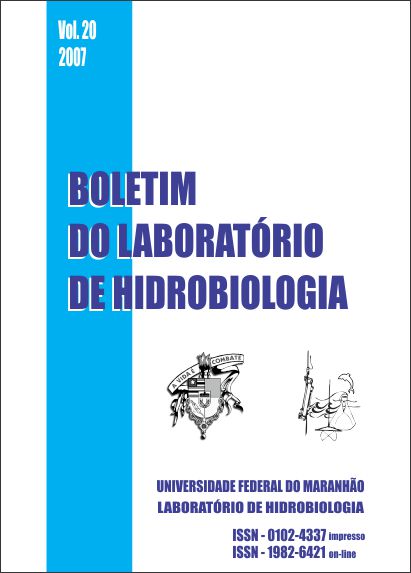PRIMEIRO REGISTRO DE CHARYBDIS HELLERII (MILNE EDWARDS, 1867) PARA O LITORAL MARANHENSE – BRASIL. (CRUSTÁCEA, DECAPODA, PORTUNIDAE)
DOI:
https://doi.org/10.18764/Palavras-chave:
Invasor, Charybdis hellerii, Maranhão.Resumo
O objetivo deste trabalho é informar a ocorrência do siri de exótico invasor Charybdis hellerii no litoral do Maranhão. As coletas foram realizadas nos meses de fevereiro a julho de 2005, onde foram capturados trinta-três espécimes em quatro locais: Praia de Panaquatira (02° 28' S e 44° 02' W), Praia do Araçagy (02° 27' S e 44° 10' W), Praia da Ponta d’Areia (02° 30' S e 44° 19 ' W) e Praia de Jacamim (02° 38' S e 44° 17' W) ao longo da zona entre marés em substrato rochoso. Os espécimes foram submergidos em uma solução de MgCl2 e então levados para o laboratório. Foram tiradas medidas de morfológicas usando paquímetro com de precisão 2 mm. Foram aferidas as medidas de largura de comprimento das carapaças do dos siris. Depois disso, os animais foram gelados preservar as características de diagnóstico, como cor. Entre os machos, a menor e a maior medida comprimento/ largura foram respectivamente 42,34mm/ 59,16mm e 18,30mm/ 25,16mm. Entre as fêmeas, a menor e a maior medida comprimento/ largura foram respectivamente 33,26mm/ 45,54mm e 15,0mm/ 21,06mm. Diversas características da biologia de C. hellerii favorecem a invasão de novas áreas, destacando-se a sua maturidade sexual precoce e a sua dieta exclusiva carnívora generalizada tornando-o um grande competidor das espécies comercialmente importantes da fauna local.
ABSTRACT
The aim of this work is to report the occurrence of the nonindigenous crab Charybdis hellerii in Maranhão littoral. The collections were accomplished the months of February and July of 2005, where thirty-three specimens were captured in four sampling sites: Panaquatira (02° 28’ S e 44° 02’ W), Araçagy (02° 27’ 56” S e 44° 10’ 55” W), Ponta d’Areia (02° 30’ 19” S e 44° 19’ 14” W) and Jacamim (02° 38’ 12” S e 44° 17’ 50” W) beaches along the intertidal rocky substrate. The specimens were drowned in a MgCl2 solution and then carried out to the laboratory. Morfological measurements were taken using vernier calipers, accurate to 2 mm. After that, the animals were frozen to preserve the diagnostic characteristics, like colorimetry. Among the males, the smallest and the largest measure length / width was 42,34mm respectively / 59,16mm and 18,30mm / 25,16mm. Among the females, the smallest and the largest measure length / width was 33,26mm respectively / 45,54mm and 15,0mm / 21,06mm. Several characteristics of the biology of C. hellerii favor the invasion of new areas, standing out your precocious sexual maturity and your carnivorous exclusive diet widespread turning him/it commercially a great competitor of the species important of the local fauna.
Keys-word: nonindigenous, Charybdis hellerii, Maranhão.Downloads
Referências
BERMAN, J., HARRIS, L., LAMBERT, W., BUTTRICK, M. & DUFRESNE, M. 1992. Recent invasions of the Gulf of Maine: three contrasting ecological histories. Conservation Biology, 6(3): 435-441.
CAMPOS, N. H. & TÜRKAY, M., 1989, On a Record of Charybdis hellerii from the Caribbean coast of Colômbia (Crustacea: Decapoda: Portunidae). Senckenbergiana Maritima, 20(3/4): 119-123.
CARLTON, J. T. & GELLER, J. B., 1993. Ecological roulette: the global transport of nonindigenous marine organisms. Science. 261, 78-82.
COELHO, P. A. & SANTOS, M. C. F., 2003, Ocorrência de Charybdis hellerii (Milne Edwards, 1867) (CRUSTACEA, DECAPODA, PORTUNIDAE) no litoral de Pernambuco. Boletim Técnico Cientifico CEPENE, v. 11, n. 1, p. 167-173.
COMMITTEE ON SHIP BALLAST OPERATIONS, 1996. Stemming the tide. Washington D. C. Ed. Nacional Academy of Sciences.
GLOBAL INVASIVE SPECIES PROGRAM, 2005. América do Sul Invadida: A crescente ameaça das espécies exóticas invasoras. Ed. GISP, 80P.
GROSHOLZ, E. 2002. Ecological and evolutionary consequences of coastal invasions. Trends in Ecology and Evolution, 17(1): 22-27.
HAYES, K. R. & SLIWA, C. 2003. Identifying potential marine pests – a deductive approach applied to Australia. Marine Pollution Bulletin, 46: 91-98.
HUXEL, G. R. 1999. Rapid displacement of native species by invasive species: effects of hybridization. BIOLOGICAL CONSERVATION, 89 143-152.
KADO, R. 2003. Invasion of japanese shores by the NE Pacific barnacle Balanus glandula and its ecological and biogeographical impact. Marine Ecology Progress Series, 249: 199-206.
LEMAITRE, R., 1995, Charybdis hellerii (Milne Edwards, 1867), a nonindigenous portunid crab (Crustacea, Decapoda, Brachyura), discovered in the India river lagoon system of Flórida. Poceedings of the Biological Society of Washington, Washington, v. 108, n. 4, p. 643-648.
MANTELATTO, F. L. M.; DIAS, L. L., 1999, Extension of the know distribuition of Charybdis hellerii (A. Milne Edwards, 1867) (Decapoda, Portunidae) along the western tropical South Alantic. Crustaceana, Leiden, v. 72, n. 6, p. 617-620.
MANTELATTO, F.L.M. Aspectos biológicos do Brachyura Indo-Pacífico Charybdis hellerii (CRUSTACEA) na região de Ubatuba, São Paulo. Anais do XXIII Congresso Brasileiro de Zoologia. p. 133. Mato Grosso, 2000.
MINISTERIO DO MEIO AMBIENTE, 2006. Espécies exóticas invasoras: Situação Brasileira. Ed. MMA, 25p.
OCCHIPINTI-AMBROGI, A. & SAVINI, D. 2003. Biological invasion as a component of global change in stressed marine ecosystems. Marine Pollution Bulletin, 46: 542-551.
RATHBUM, M. J., 1930, The Cancroide Crabs of America of the families Euryalidae, Portunidae, Atelecyclidae, Cancridae and Xanthidae. Bulletin of the United States National Museum, 152: 1-608.
RUIZ, G. M., FOFONOFF, P. W., CARLTON, J. T., WONHAM, M. J.& HINES, A. H. 2000. Invasion of coastal marine communities in North America: apparent patterns, processes, and biases. Annual Review of Ecology and Systematics, 31: 481-531.
STACHOWICZ, J. J., WHITLATCH, R. B. & OSMAN, R. W. 1999. Species diversity and invasion resistance in a marine ecosystem. Science, 286: 1577-1579.
TAVARES & MENDONÇA Jr., 1996, Charybdis hellerii (A. Milne Edwards, 1867) (Brachyura: Portunidae), eighth nonindigenous marine decapod recorded from Brasil. Crustacean Research, n° 25: 151-157.
TAVARES & MENDONÇA Jr., 2004, Água de Lastro e Bioinvasão. Rio de Janeiro: Editora Interciência. Capitulo 6. p. 59-76.







